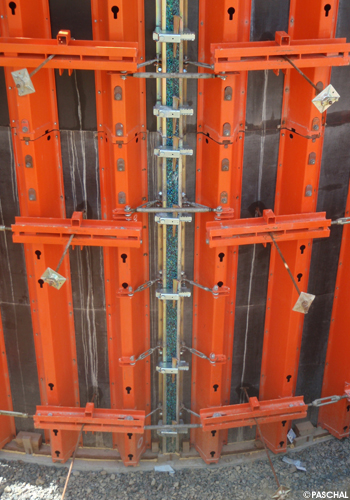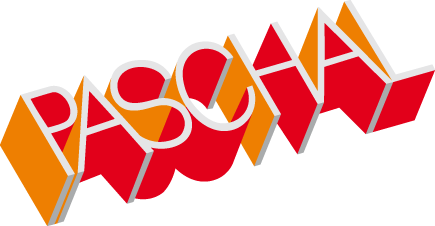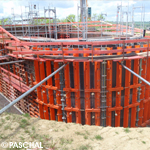Modern, approachable water supply structure
Construction site report
Elevated tanks for 1,200 m³ of drinking water as a waterproof concrete structure on behalf of Stadtwerke Zweibrücken GmbHA waterproof concrete structure in one "cast" for the drinking water supply has been made available by rented formwork and shoring systems by PASCHAL: 580 m² LOGO.3, 180 m² TTK, 280 m² PASCHAL Deck and 314 m² GASS.
The original elevated water tank built in 1930 will be taken out of commission after the completion of the new construction.
The new structure, designed according to the plans of CP Beratende Ingenieure GmbH & Co. KG, Spiesen-Elversberg, and the architecture firm Molter Linnemann Architekten BDA from Kaiserslautern on behalf of Stadtwerke Zweibrücken GmbH, will then ensure the drinking water supply of the southern zone of Zweibrücken for the coming decades.
According to the architect's plans, the shape evolved from the environment itself. The gable peaks of adjacent buildings, which are visible from the foot of the slope, are reflected in the diamond-shaped facade field that will be the only visible part of the building after the underground reservoir is covered with earth. Only contours of the overall structure will be perceptible.
The designers planned the new structure so that visiting groups can also experience the inner workings of the supply building; extensive glazing ensures a view of our number 1 resource during the tours. Due to hygienic demands and aesthetic reasons, all concrete surfaces have been executed in exposed concrete quality.
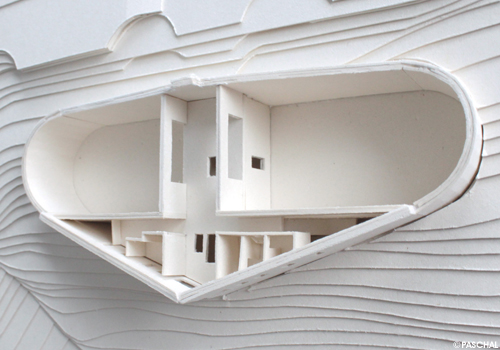
The building model, embedded in the modelled landscape, displays the two water chambers on the left and right, with the centrally located technical room.
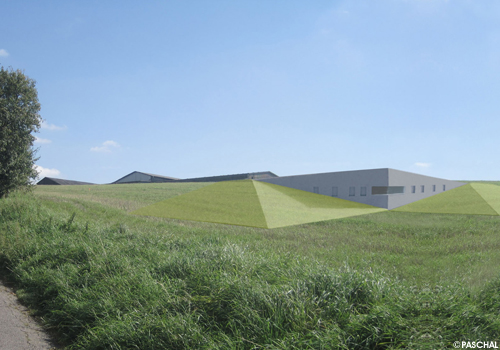
The visualisation of the draft documents the integration of the supply building in the countryside, which is complemented by its green roof.
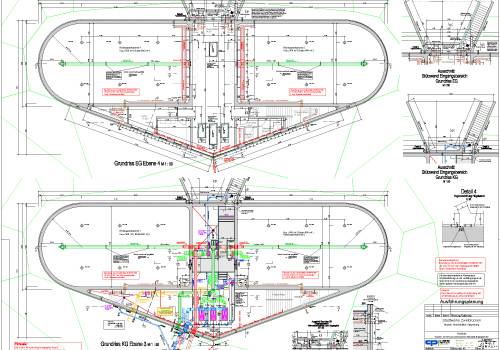
The engineering of the structural and technical planners illustrates the sophisticated design geometry – above all through the requirement that the two water tanks had to be constructed without vertical concrete sectional joints.
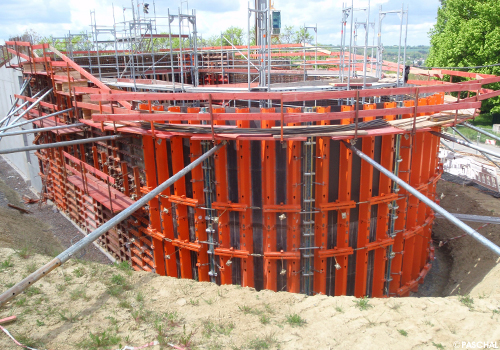
The "Galgenberg" project also shows the excellent practicality and system compatibility of TTK, LOGO.3 and the shoring system GASS for quick casting of challenging concrete structures.
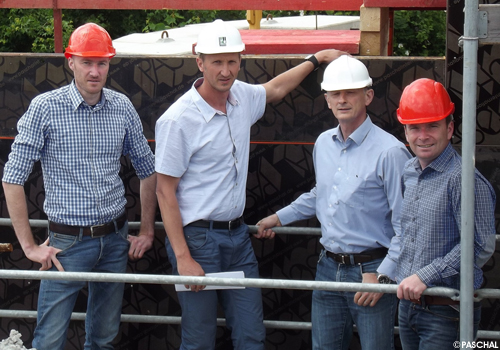
After 9 months of construction, the involved quartet is highly satisfied with the construction process, the quality achieved and the construction costs.
From left to right: Johannes Werth, Formwork Consultant, PASCHAL; Elmar Anna, Site Manager and Daniel Brill, Managing Director of WOLF & SOFSKY SF Tief- und Ingenieurbau GmbH; Carsten Rupp, HSB Schalungstechnik.
Skilfully combined formwork components
For the formwork of the concrete structures, the executing contractor, WOLF & SOFSKY SF Tief- und Ingenieurbau GmbH, which specialises in the turn-key construction of plants and technical facilities for supply/waste management, relies solely on formwork and shoring components by PASCHAL. During the complex bidding phase, the calculation department of WOLF & SOFSKY SF Tief- und Ingenieurbau GmbH was already actively supported by the PASCHAL partner HSB Handels- und Servicegesellschaft für Baumaschinen mbH, and the formwork design was supported by PASCHAL. This service was essential for the executing contractors in order to compile the complete quotation as well as to ensure compliance with the DVGW (German Association for Gas and Water) regulations.
Due to the specified architecture, the structural engineering and the DVGW regulations for drinking water storage, TTK, LOGO.3, PASCHAL Deck and the shoring system GASS were combined from the PASCHAL range in order to build the entire concrete structure with system formwork components.
Hygiene requirements
To ensure compliance with the strict hygiene requirements, regulated in DVGW worksheet W 347 (A), the executing contractor had to submit comprehensive material samples and demonstrate organisational and personnel qualifications.
Because of the DVGW regulations, an absolutely closed-faced exposed concrete surface was specified for the concrete structures for the insides of the container, which, without further coating, comply with the requirements of DVGW worksheet W 347 (A) " Hygienische Anforderungen an zementgebundene Werkstoffe im Trinkwasserbereich – Prüfung und Bewertung " [Hygienic requirements for cement settled materials used in the drinking water sector – testing and assessment]. Therefore, all wall formwork for the inside tank walls – combined from LOGO.3 and TTK – were coated on site with Zemdrain by Max Frank. The high-quality result is further convincing evidence of the functional and costeffective combination of the frame formwork by PASCHAL combined with Zemdrain.
Since the two water basins are designed as mirror images, the formwork segments by PASCHAL were combined so that they could be used twice. The carefully considered and implemented "allocation" of the formwork on site by the inhouse construction team of WOLF & SOFSKY SF Tief- und Ingenieurbau GmbH with Zemdrain enabled the dual use, with a result with which the client and the construction manager Dipl.-Ing. Elmar Anna and foreman Rüdiger Nagel are all very satisfied.
Exceptional details
Even the detail adjustments that were required during the construction phases were immediately resolved by the involved team, consisting of Dipl.-Ing. Daniel Brill Managing Director of WOLF & SOFSKY SF Tief- und Ingenieurbau GmbH, Dipl.-Ing. Elmar Anna, Dipl.-Ing.Carsten Rupp of HSB Handels- und Servicegesellschaft für Baumaschinen mbH and Johannes Werth, Formwork Consultant at PASCHAL, with the result that all parties involved in construction were completely satisfied with the progress in terms of quality, time and construction costs.
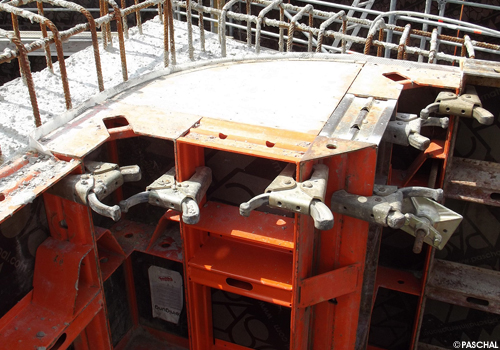
The corner joints – the partition wall to the technical room with the transition to the outer wall of the drinking water reservoir – had to be designed with a 90° exterior corner and a round interior one. This was no problem for the PASCHAL systems and everything in the system contributed to rapid progress and a good result.
Waterproof concrete with exposed concrete and hygiene requirements
For the two water reservoirs, it was specified that there should be only two concrete sectional joints each:
- Reinforced concrete floor slab to the vertical enclosure walls,
- Reinforced concrete roof slab to the vertical enclosures.
Other special features were the floor slabs (each with a 5.75% incline), the sloping wall completion of 6.00 to 8.00 m, the semicircular basin with a radius of 4.75 m, the vertical partitions as a demarcation to the central technical room with integrated pressure water doors and the window openings above the water level as well as the two rounded shapes of the 90° corners and the two wall displacements to the arrow-shaped continuation of the concrete outer walls.
Vertical concrete structures without concrete sectional joint(s)
After the 560 m², 60 cm thick, comprehensive floor slab was cast with formwork panels composed of LOGO.3 and the specified surface inclination was concreted and hardened, the entire wall formwork of one drinking water reservoir was assembled.
For this purpose, the formwork systems LOGO.3 and TTK were combined according to the PASCHAL formwork drawing. Subsequently, the individual formwork units for the inside walls of the tank were coated with Zemdrain. Wedge-shaped timber fillers were mounted on the slightly inclined floor slab as the first "formwork unit". The basis for the production was the formwork planning by PASCHAL and the implementation planning of Wolf & Sofsky SF Tief- und Ingenieurbau GmbH. The wall-high formwork segments were placed on these timber fillers and fixed on the lower frame of the formwork. On the sloping floor slab, the TTK – the trapezoidal girder formwork with a clamp connection – was once again able to prove what it can do. Using the clamp technique, unlimited flexible element offset is possible and the solid connection of the elements with and without filler is quickly and securely ensured.
The integrated parking positions for the connecting clamps provide for an orderly construction process, for example when moving the formwork units.
Formwork units used twice
How quickly and flexibly the implementation of entire formwork units can be in practice was also seen at the construction site in Zweibrücken: Since all the diagonally symmetrical across the longitudinal axis formwork units for the water basins were used again, the combined formwork units fit together perfectly; the connection elements, the clamps, were always at hand thanks to the parking positions.
Parties involved in the construction project:
Client / Developer:
Stadtwerke Zweibrücken GmbH
www.stadtwerke-zw.de
Architect:
Molter Linnemann Architekten BDA, Kaiserslautern
Structural Engineer/Planner:
CP Beratende Ingenieure GmbH & Co. KG, Spiesen-Elversberg
Construction company / plant construction:
Wolf & Sofsky SF Tief- und Ingenieurbau GmbH, Zweibrücken
PASCHAL-Schalungsservice in cooperation with:
HSB Handels- und Servicegesellschaft für Baumaschinen mbH.
HSB has been a PASCHAL retailer since the very beginning and, for 30 years, a distributor for Saarland, parts of Rhineland-Palatinate and Luxembourg. At its Ensdorf site, the company has a large range of rental equipment on its premises, from which it can provide customers with formwork for walls and slabs. An inhouse technical office as well as active customer support through sales representatives are a matter of course for the service-oriented company.
HSB and PASCHAL have already completed many projects together, ranging from small retaining walls to large industrial and infrastructure projects and major projects in the civil engineering and building construction sectors.
HSB Schalungstechnik is a division of HSB Handels-und Servicegesellschaft for construction machinery and has, for many years, been a much sought after partner for the construction industry for civil and building engineering.
Right from the quotation phase, HSB supported Wolf & Sofsky SF Tief- und Ingenieurbau GmbH in preparing a competitive quotation. During the construction work, HSB supplied its own formwork material to the construction site on a rental basis:
www.hsb-baumaschinen.de
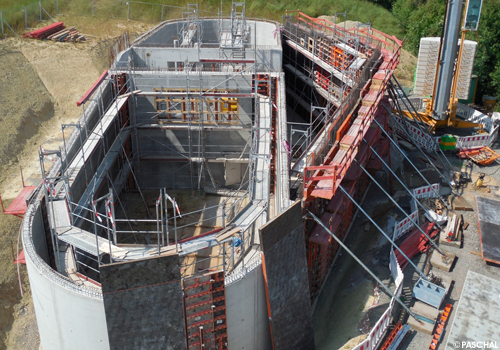
The concrete wall of each pure water chamber had to be built without any vertical joints. Therefore, each basin enclosure was built with 120 m³ of waterproof concrete in one step.
For the arrow-shaped outer wall, which is 8.00 meters high at its highest point (in the photo, formed with LOGO.3), 70 m³ of concrete were incorporated in a single operation.
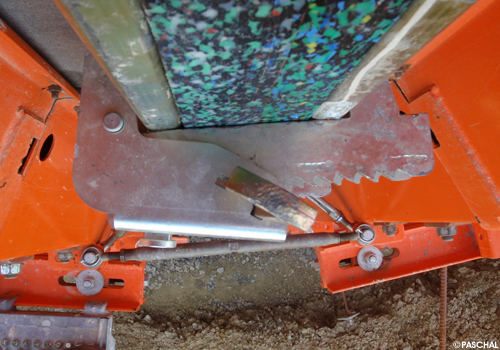
TTK – the trapezoidal girder formwork with a clamp connection in detail
The advantages of TTK were proven once again on site in Zweibrücken:
With only a few connectors, the formwork segments can be quickly and safely connected with and without plastic fillers, whether on a straight or an inclined plane. The "park option" for the clamp on the formwork frame improves the construction process.
